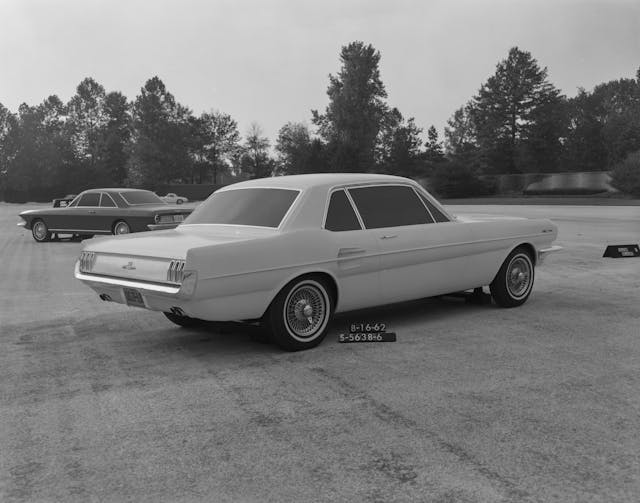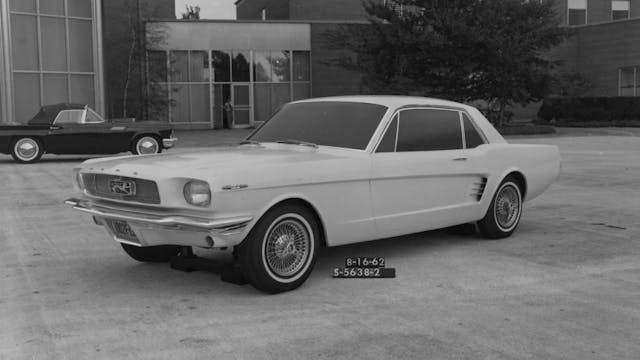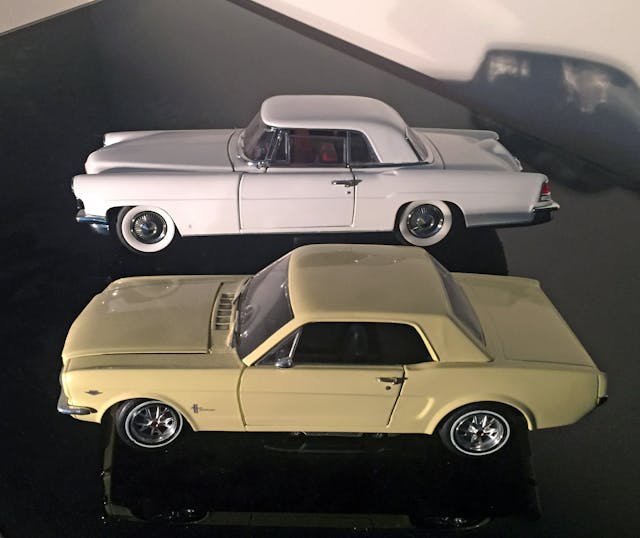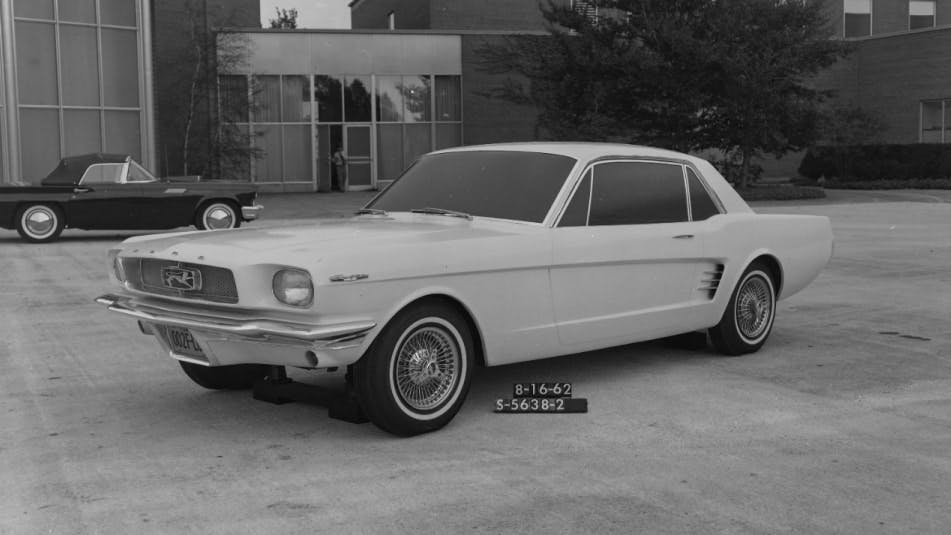Media | Articles
Celebrate the Ford Mustang’s 57th birthday with these just-unearthed development documents
By now we all know the story of Ford executive Lee Iacocca, in the 1960s, anticipating the buying power of the baby boomer generation as they came of age. He correctly perceived that they’d be down like James Brown for a small car with sporty flair and a value price. Now, in concert with the Mustang’s 57th birthday, Ford is adding to the narrative with more details from its archives. The Blue Oval has unearthed previously unseen documents from when the famous pony car existed only under the T-5 or “Special Falcon Project” designations. There’s a lot of history to unpack, so let’s get to it.

First, however, it’s important that we remember the automotive context of the early 1960s, when the “Special Falcon Project” was in development. For one, consider the radical nature of the 1960 Chevrolet Corvair, particularly the top-tier Monza coupe or convertible and the type of buyer (young, aspirational) these variants would attract. Ford management knew that it would be scuffling in the marketplace with the Corvair, as well as affordable imports like the VW Beetle. To challenge the innovative competition, Ford would have to come up with creative, yet still realistic solutions.
Though the Special Falcon Project would eventually win out in the form of the Mustang, it was not the only option Ford considered. What about grafting a 1955–57 Thunderbird body onto the unibody of the 1961 Ford Falcon? Behold the XT-Bird, the result of a collaboration with the Budd Company in 1961. It even looked ready for production thanks to all that recycled metal (including the dashboard). The XT-Bird did fulfill Lee Iacocca’s need to make something for up-and-coming baby boomers, and there were no safety concerns of using outdated technology. (You could make anything back then—not to mention Ford got seriously burned by its 1956 Lifeguard system when the company actually tried to make a buck on safety—so this sporty Monza alternative had some merit.) Wisdom prevailed, thankfully, and internal documents articulate how Ford put the XT-Bird to bed.
Imagine being a person that went through hell in the Great Depression, finally got into the swing of things during the Truman administration, spent $3200-ish for Ford’s finest flagship T-Bird in 1955 only to have some darn baby boomer whippersnapper buy the same basic shape a decade later for two-thirds of the price you paid back then. That’s how XT-Bird financials would have likely stacked up in 1965, not to mention a too-recent retro throwback might have had limited appeal. Remember, this was the counter-culture 1960s; would forward-looking boomers really want their grandpa’s Thunderbird?
Marketplace
Buy and sell classics with confidence
Furthermore, as the memo states, the XT-Bird would have been superfluous assuming the Special Falcon Project also came to life. The latter would have a lower unit variable cost, which ultimately bore delicious fruit when Ford made 121,538 Mustangs in 1964 and a whopping 559,451 in the full year of 1965.
So there were at least two plausible reasons to ditch the XT-Bird and stick with the Special Falcon. And the tone of this note suggests Ford was far more interested in making the Special Falcon a reality. Below is rare insight into precisely how the Special Falcon became our beloved Mustang.
Page two has some interesting requests: keep the cost down by prioritizing interchangeability with the Falcon, don’t resemble anything else Ford makes, and it better not look like a Monza, either. The end result was indeed affordable and unique to any Ford of the era. But was it influenced by any other Ford product?
Yes, and as I hope to show with my scale models, the Mustang sported callbacks to the Lincoln Continental, especially via the star-crossed 1956 Continental Mark II. The Continental’s scalloped headlight buckets lived on via this cheaper-to-make form, the sheetmetal’s up-kick behind the doors became a styling element strong enough to change the quarter window’s curvature, but most importantly, the “long hood, short deck” proportioning moved from the ultimate in 1956 exclusivity ($10,000) to something just about anyone could afford in 1965.
The Edsel Ford-worthy proportioning was indeed the Mustang’s pièce de résistance. We are, however, veering off into design tangent, so let’s refocuses with more internal documents that illuminate the development of America’s first iconic pony car.
From the perspectives of pricing, project management scheduling, and a go/no go deadline (i.e. put up or shut up after November 19th, 1962), this “August Planning Document” is a delightful read for those looking to go behind the scenes of the Mustang’s creation. It’s within the scope of constraints like this where the realities of production play out. But wait, there’s more!
As with any business plan, reading the Executive Summary gets you the gist of the Special Falcon Program, including everything from demographic information to detailed costs for so many components. Once again note how many times the Monza comes up in this document.
Sick of reading documents yet? Don’t worry, the next batch has just what you need.
The design chronology of the project, newly minted as the T-5 program in order to distinguish it from the Falcon origins, is fairly straightforward. What’s less obvious are the influences. Take, for example the strong impression the 1961 Thunderbird on the first concept (dated 11-13-61 in the photo). The second concept (also dated 11-13-61) has a more vintage 1950s feel about it, down to the wraparound glass, and a strong bodyside swage line leading to minuscule tail fins. No doubt Ford was a long way from reaching the Mustang’s imminently successful design.
The third (dated 5-29-62) is getting warmer. There is clearly a 2+2 greenhouse, but this concept’s jagged front and rear fascias appear more akin to those of the 1958 Plymouth Fury. Now go to page 5, and note that this un-dated photo coincides with Exhibit IV on the first page. Here we see the Mustang’s resemblance to the Continental via its long hood/short deck sense of proportioning. The front end feels a bit too Corvair-like, while the rear glass looks straight from the 1950s; management was right to disapprove of this design while simultaneously approving the overall project on July 31, 1962.
Pages 7-9 show a handful of proposals, and while most possess the Continental-like proportioning, it’s clear that M-7 was the proposal that won everyone’s hearts as the details (side sculpting, more unique nose, anything-but-1950s-retro taillights, etc.) were truly right. It was going to be a unique product, one that catered to a soon-to-be red-hot demographic. Lastly, page 6 has the Mustang design that we all know and love.
There’s more to the Mustang’s story, as we can see thanks to Ford providing program manager Hal Sperlich’s Status Report #1 to Lee Iacocca on October 3, 1962. If you are one of the true believers that can’t get enough Ford Mustang, you’ll want to soak up every line of the massive document below.
Ford definitely did us a solid, as this was a fantastic birthday present for all of us to enjoy!






